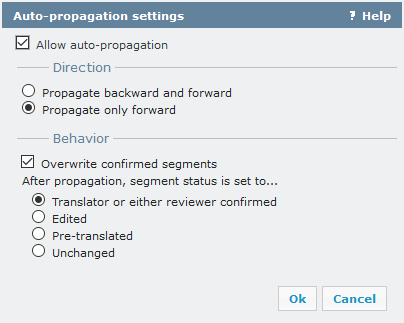Auto-propagation settings (webtrans)
Auto-propagation ensures that the translation of repeated segments is consistent. When it is turned on, memoQweb always checks if the segment you translate and confirm is a repetition. If it is, memoQweb inserts the same translation in every repeated segment in the rest of the current document or view. After you turn on auto-propagation, it's automatic.
Before you turn on auto-propagation, make sure to check the context of your translations.
How to get here
From memoQweb (legacy):
- Open webtrans in your browser.
- In the list of documents, click a document's name. It opens on a separate browser tab, in the webtrans translation editor.
-
On the translation editor's toolbar at the top, click the Auto-propagation icon.
The Auto-propagation settings window opens:

From memoQweb:
- Sign in to memoQweb with your user account details.
- If memoQweb does not show the webtrans page, click the webtrans icon on the left sidebar.
- Click the project that the document belongs to, then click the document's name. It opens on a separate browser tab, in the webtrans translation editor.
-
In the translation editor's toolbar at the top, click the Auto-propagation icon.
The Auto-propagation settings window opens:

What can you do?
First, make sure that auto-propagation is turned on: Select the Allow auto-propagation checkbox.
Normally, memoQweb updates the repeated segments in the rest of the document - that is, the segments after the current one.
If you need to update segments before and after the current segment, click the Propagate backward and forward radio button.
If memoQweb is set to propagate backward and forward, and you want to return to the forward-only way: Click the Propagate only forward radio button.
After memoQweb inserts a translation in the repeated segments, it can change the status of that segment. You can choose which status memoQweb should use:
When you finish
To save your changes: Click OK.
To return to your translation without changing the settings: Click Cancel.